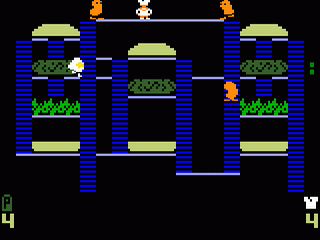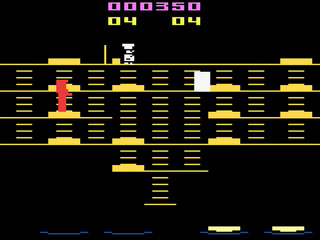
With Super Burger Time primed to flip patties on Antstream Arcade, we thought it would be a good time to have a look back to where it all started. So here’s Antstream Arcade's hot take on this underrated series that began 36 years ago during the heyday of the video game arcades. If you enjoy this article, why not like our Facebook Page for more retro fun, or sign up to our mailing list, to find out more about Antstream Arcade, the new retro gaming streaming service that lets you play thousands of games, on multiple devices with just one account!
Eighties arcades were a tough environment for gamers. Simply grill anyone of a certain age who has been distressed by Defender, grumbled at Gravitar or just plain-lost-their-rag with Joust, and you’ll know that these were games designed to suck you in with their gaudy colours and endearing sound effects, before extracting as many 10p pieces as possible from your pocket. BurgerTime, released by Data East in 1982, continued this tradition and used the arcade company’s own interchangeable Deco Cassette system. Each game was released on an audio cassette and loaded into a bespoke cabinet by the arcade owner, saving considerable costs in shipping and logistics. Unfortunately, the system had its drawbacks (the cassettes proved unreliable for example), and most of its games were also renowned for being harder than a late Triassic rock armed with a flick-knife.

Originally called Hamburger in Japan, BurgerTime is the story of Chef Peter Pepper, working in a busy high-pressure, fast-food restaurant. Baying customers are demanding their burger fix, but Pepper has a rather unusual problem: some of the food has come to life and is chasing him around his kitchen. Fortunately Pepper has his trusty pepper cellar to temporarily stun them, and walking over the burger ingredients also knocks them down to a lower level. Should any of the naughty foodstuff be wandering underneath they are squished and removed from the screen, albeit for a short period. Knock all the burger parts to the bottom of the screen and the orders are ready, and it’s on to the next, more devious, level. As with all classic games, the concept is deceptively simple; it’s not long before Chef Pepper is frantically dashing around the levels, up and down ladders, and dodging the ever-faster enemies such as Mr. Egg and Mr. Hot Dog.
Yet despite its toughness, BurgerTime proved very popular with arcade goers, and while it never spawned a direct sequel, there have been plenty of spin-offs and updates. Firstly, the original itself was ported to a number of home computers and consoles, including the Atari 2600, Apple II, NES and Colecovision. But perhaps the best conversion was for the Intellivision, which was crucially a little easier, and became one of the biggest-selling titles for the Mattel console.

In the arcades, Data East took a sideways step and created Peter Pepper’s Ice Cream Factory, which although still a one-screen game, is quite different in terms of gameplay. Now working at a dessert-based establishment, Pepper must kick ice-cream into cones, which sounds as improbable as it is unhygienic. Since BurgerTime, our beloved chef appears to have got out of shape, however, and his slow movement makes this game a bit of chore to play.

Next up for Pepper was a console-only oddity, and on the machine that had benefitted earlier from an excellent home port of the original game. Released in 1987 on the Mattel Intellivision, Diner greatly expanded on BurgerTime’s concept, and was created by the same coder of the Intellivision game, Ray Kaestner. Given an isometric 3D viewpoint, Pepper is now managing his own restaurant, and has to run around kicking food back onto its plate. Written for RealTime Associates and INTV Corp (Mattel had gone bust several years earlier, a victim of the American videogame market crash), Diner used code from earlier Mattel games and evoked the spirit of BurgerTime, if not the design and look.

Finally, in 1990, BurgerTime got a proper update in the arcades, and it’s one of our favourites here at Antstream. Super Burger Time greatly improved the original’s graphics (as you might expect given the eight-year wait) and also expanded its gameplay. While the core principal of Super Burger Time remains the same – jump on burger segments so they drop to the level below and eventually form a complete burger – there’s some much needed variety added to this update. Interestingly, it also stars Peter Pepper’s kids. The junior Peppers have also upgraded their kitchen with some new weapons, such as a frying pan that can be collected and used to bash those naughty veggies. They can also jump, a helpful option for when things get really sticky, and they glide across the screen with a swiftness that belies their ample frames. Of course, things are soon hotting up, as hordes of enemies flood each level, and some of them even lob fragments of food at our poor put-upon short order cooks.
As with any arcade game of the Eighties, imitation proved to be the sincerest form of flattery, and clones of BurgerTime appeared on a variety of home consoles and computers. The best of these are Ocean Software’s Mr. Wimpy and Blaby’s Barmy Burgers. Since Super Burger Time, there have been no more arcade visits for Chef Pepper, but we’ve seen Burger Time Deluxe on the Gameboy, - although this was essentially the original game plus a handful of new levels, and some appropriately sweet music. The Gameboy Color also got a BurgerTime game in the form of the strange Flintstones mash-up BurgerTime In Bedrock.

In 2011, there was a misguided attempt to bring BurgerTime into the third dimension - BurgerTime: World Tour unfortunately lost much of the original’s charm in the process and received poor reviews upon release.
Yet that does little to dull the shine of the two original arcade games, BurgerTime and Super Burger Time, the latter which remains our favourite episode in the story of that poor overworked Chef Pepper.








Comments